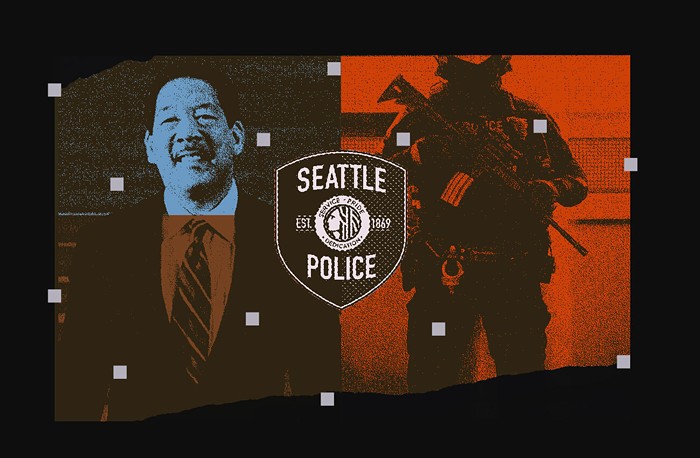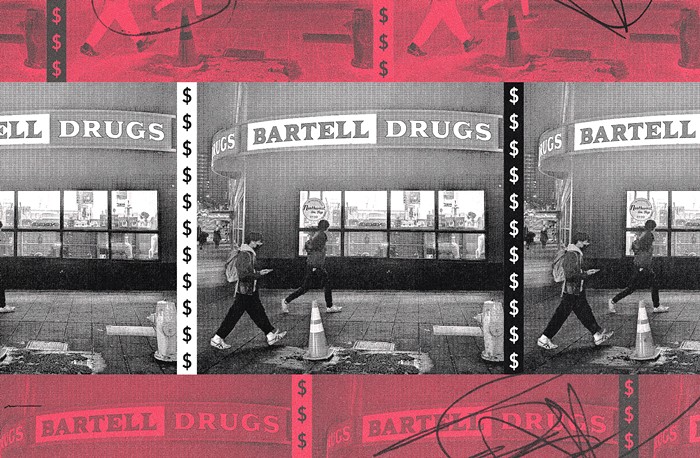This much is apparent after one listen to his EMI U.K. Songbook Series CD, Where Were You When the Fun Stopped? It's part of a set built around 10 left-field artists' personal record archives--each was invited to compile their own musical compendium, as well as supply artwork and sleeve-notes. The result, according to the effusive EMI press release which accompanies the collection, is like being invited over to the artists' places for a drink. If this is the case, then Gonzo acolytes are in for a bitter surprise, because Thompson is even more prosaic than they are. He might claim that "music has always been a matter of energy to me, a question of fuel," but his favorite songs all verge on mass consumerism. Is this what inspired the drug-induced, frenzied writing of Fear and Loathing in Las Vegas (as Hunter claims: top down, wind blowing through his hair, the great open desert in front of him)--or was it, as we always suspected, just the drugs?
Thompson has no passion for music--not a consuming one, at least. If you can usually judge a person by what they listen to (and by the friends they choose; the clothes they wear), then what does it say about Thompson that his idea of "extreme" is to always opt for the most obvious, pedestrian route? Look at his choices: Bob Dylan's "Mr. Tambourine Man." Rod Stewart's "Maggie May." Lou Reed's "Walk on the Wild Side." Jefferson Airplane's "White Rabbit." Don McLean's "American Pie." And so on, and so on. Virtually nothing from the last three decades beyond the odd Lyle Lovett and Tanya Tucker country-style reinforcement of tradition. No wonder he's been a recluse in Colorado for over a decade now. Life holds no surprises for this tired old man.
Yet, on the CDs accompanying the booklet, he still has the temerity to quote fellow baby-boomer Warren Zevon in inch-high block capital letters: "JESUS MARAUDING CHRIST, THIS IS THE HIPPEST ALBUM IN THE WORLD." It's like these pathetic ex-hippies believe the times of their lives were the best possible times anyone could ever have. How '60s! "You have resurrected fun," Thompson's fawning neophyte "The Colonel" adds, pictured in the booklet cocking a "rare" .454 Casul Magnum with the no-good Doctor, before going on to throw in some extremely lazy redneck fantasies involving speed, Mescal, and "dark-skinned beauties" as proof.
How lame! Thompson obviously partied too much one summer and never got over it. In the same way that there's nothing lasting about his contribution to culture, there is nothing of worth in his taste. Weren't the weird, psychotic Ralph Steadman illustrations the only notable aspect of Fear and Loathing anyway?
The link between popular music and culture has been well documented. From Andy Warhol's Factory collaboration with the Velvet Underground in the '60s to clothes designer Vivienne Westwood's Sex shop shenanigans along the Chelsea Rd. with the Sex Pistols in the '70s, through the countless musical references which litter this decade's best-selling soccer writing by English boy-wonder Nick Hornby (his new book About a Boy actually takes its title from a Nirvana song), artists have long looked toward the musical world for a little added credibility; a little more youth appeal. Check out Turner Prize-winning artist Damien Hirst (famous for cutting a cow in half and sticking the two halves in formaldehyde), and his continued flirtation with the Letterman-sanctioned Blur (whose bass-player Alex James collaborated with Hirst on a U.K. Top 5 single last year, extolling the virtues of yobbism). Yet surely, there's a massive contradiction in the bedding down together of pop music and culture--even lowbrow culture.
Pop music is ephemeral, throwaway. It's there to be used one day, discarded the next. If there's one defining factor linking the 10 artists in this Songbook series, it's that they've all got an inflated sense of self-worth (Fabulous Furry Freak Brothers creator Gilbert Shelton excepted). Almost all of the cartoonists and writers have included tracks on their CDs which feature themselves (for example, Peter Bagge's own lame-ass approximation of '60s power-pop, the Action Suits, who close his Rockin' Poppin' Favorites CD). Of course they believe themselves to have more importance than the next person, otherwise why would they bother doing what they do? And yet--almost without exception--their musical tastes are rank. If their tastes are a reflection of their own selves, then surely most artists have the same inner, shallow selves as the rest of us.
Take horribly trendy Scottish author Iain Banks (responsible for the densely written The Wasp Factory) and his horribly trendy taste in music. Banks' taste is so narrow and self-consciously hip (that is if you're still living in 1983) that it's stereotypical. Sex Pistols, Radiohead, the Waterboys, Devo! Didn't this Northern prick ever listen to any music before the age of 18? (Yes, as his inclusion of dour, Northern, flute-wielding Jethro Tull and Bowie's "Heroes" proves. It's suspiciously fortunate that all his other favorite records come from after 1976, Year Zero for punk in England: to have chosen differently would've shown him up to be less than fashionable--something no self-respecting left-field artist could countenance.) One look at his CD's track listing should warn you off from buying his unreadable novels.
At least Seattleite Hate cartoonist Bagge has the courtesy to admit that the music he enjoys was mostly created by hacks (the Monkees-style Association, the peerless Spice Girls, the white-fronted funk band KC and the Sunshine Band). Yet what should we read from his sumptuously packaged collection, which includes the Hollies' brittle "I Can't Let Go," the Knack's paean to underage girls, "It's You," and Jan & Dean's playtime "The New Girl in School"? That Bagge is a fortysomething teenybopper whose idea of a good tune is a production-line, third-generation rip-off of the Jackson 5 or Beach Boys? That he is anally retentive and pays way too much attention to detail? That he's dangerously obsessed with music originally intended for little girls?
One would never have guessed from his musical tastes that Bagge has made his living over the past decade from exploiting the grunge generation (Hate has sold more than two million copies around the world). Especially since he himself confesses that he can't stand "post-punk alternative music" (Sonic Youth, Pixies, etc.). Music certainly hadn't informed Bagge's art up to very recently--unless, of course, you argue that it gave him the inspiration for the title of his best known work.
In the last year, however, the influence of Bagge's musical tastes is finally being felt in his art. Not only has Pete come up with some inspired Roundtable Pizza ads (thus giving vent to his deep-rooted feelings of admiration for "hack merchants"), but his new CD comic Yeah is about a trio of galaxy-beating female pop stars, based closely on the Spice Girls. Bagge overcomes the contradiction of pop music being linked with pop culture by being so up front in his acknowledgment that his chosen field is as ultimately throwaway as pop culture--but others aren't so smart.
What can we learn from examining these CDs?
That puppet master Gerry Anderson (Thunderbirds, Stingray, Space: 1999) is a first class buffoon who never got over the Second World War, nor the fact that his animated creations fell out of fashion in the '70s. Look at his selections: a Dire Straits song ("Calling Elvis") which he helped make the video for; theme music to his various series like Thunderbirds and Lavender Castle; interspersed with snatched radio memories from the war (Maurice Ravel's "Bolero," the Red Army Choir's "Cossack Patrol"). Look at the selections he didn't make: Sandie Shaw's "Puppet on a String"--included only because a couple of people at EMI thought it would be a "good" idea, incredibly enough. Years after Thunderbirds composer Barry Gray died, Anderson still hasn't gotten over the fact that Gray was once more widely fêted than himself--as shown by his inclusion of two Gray compositions, neither in its original form. Anderson is every trainspotter's dream: a self-obsessed, woefully insecure pushover who is still at everyone's beck and call. Look at the poor sap on the back sleeve, holding the hands of his most famous "Supermarionations" as he waves good-bye to us. You almost start to feel sorry for him.
What else do we learn? That Gonzo artist Ralph Steadman (Fear and Loathing, Leviathan, Leonardo da Vinci) is a pretentious, cross-dressing pseud. Steadman, however, has the wit to state that his musical choices are balanced "by the desire to be moved to laughter or to tears"--he is aware of the pitfalls inherent in making a selection which commentators are going to link to his art. Hence, he is able to include some genuine oddities next to more obvious choices. For the former, there's Spike Jones' iconoclastic, Oscar Wilde-debunking "Cocktails for Two"; English folk oddball Jake Thackeray's "The Blacksmith & The Toffee Maker"; and Bob Kerr's self-explanatory "Making Whoopee." For the latter, there's himself; William S. bloody Burroughs; Leonard bloody Cohen; Billie bloody Holiday; Beet-bloody-hoven. The trouble is, by spreading his net so wide--to include classical and even 15th-century madrigal--Steadman's collection is almost unlistenable. At least you can begin to understand, however, why his drawings are so schizophrenic, warped, and unpredictable.
Forget pop music for a moment. All culture is ephemeral, throwaway. Show me someone who still reveres Shakespeare, Beethoven, the Velvet Underground, Picasso, Debussy... and I'll show you someone who can't be bothered to seek out the new, the challenging, that is always out there. (Pop culture commentators are often applauded for bringing certain "scenes" to wider attention--for example, U.K. punk '76 or U.S. grunge '89. I would argue that every area in every age has its fair share of talent--nothing stands out above anything else--all that alters is the focus, the veneration).
Are you listening Banks, Thompson... and Barker?
Best-selling horror/fantasy U.K. author and painter Clive Barker (Hellraiser, Weaveworld) is a complete sap. Only two styles of music exist for him: the mawkish and the pompous. Anything else is both distasteful and redundant. One could say the same for his own writing. Check his CD's juxtaposition of the classical next to the filmic next to the sentimental. His choices veer so radically and self-consciously between "spooky" and "safe" it's painful. I'm not doubting the sincerity of the writer's comments on South Pacific's "Bali Ha'i" ("one of the greatest songs of yearning I know") or his inspired inclusion of both Fred Astaire's classic "The Way You Look Tonight" and the tender "Baby Mine" from Walt Disney's Dumbo... but I do object to him being so overly reverential toward cod-classical music. Benjamin Britten? Oh, please. And only a true wanker could like Diamanda Galas' perfectly pitched screeching. Plus, his paintings are crap.
At least godfather of underground comics Robert Crumb's (Weirdo, Zap, Mr. Natural) selections have the merit of introducing a (presumably) completely new form of music to his audience. Anyone familiar with Crumb's meticulous, painfully autobiographical work will know of his fondness for the American dance orchestras of the '20s, and his near-legendary 78-rpm record collection. Anyone who's seen Crumb, the moving, full-length film centered around his dysfunctional family, will already understand why the cartoonist wants no truck with the second half of the 20th century--as evinced by his selections on That's What I Call Sweet Music, all from the 1920s. Good for Crumb. Here is a man who clearly searched out his favorite music, who didn't stick with the fashionable and present-day, but rooted back in the past until he found music that would suit his moods. On the positive side: That's What I Call Sweet Music, out of any of these CDs, offers the swiftest escape route from the everyday--surely the prime purpose of any art form. On the negative: I fucking hate the sound of the '20s--the only image it sparks off in my mind is that of the pampered, cosseted, white upper-middle classes lording it up while their Negro slaves toil in the kitchens.
Sorry Bob.
Cartoonist Gilbert Shelton and musician/insane drawer of monsters Savage Pencil have the best approach out of any of the 10 artists present. They don't give a fuck for reputations. They just appreciate the moment for what it is, and move straight on. They understand there's no such entity as classic, just moments in time and mood swings. Their CDs are suitably eclectic and inspired--Shelton's particularly.
Shelton's CD is a real find. A self-confessed lover of the piano, he has little time for rock 'n' roll. (A trifle odd, perhaps, for the creator of the archetypal hippie comic.) Instead, he chooses to pepper his selections with a healthy smattering of humor and boogie-woogie. Don't get me wrong: I hate "wacky" music as much as the next white-boy ex-indie fan. It's just that humor--like love, like politics, like bad rhyming couplets--is a vital part of all pop music, of all culture. An extremely vital part. Plus, most of the songs on Honky Soul, Race Music, Hard Bop & Anachronic Jazz deal in black humor--and it's always the darkest humor which is the funniest, the truest. Remember, it's only the winners who don't need their humor. As Shelton says in his sleeve-notes: "I wanted to present a lot of historical facts about these songs and the musicians, but my research turned up so many tragic stories that I decided to forget the history and just present the music."
Hence, genius '50s social commentator and Harvard math professor Tom Lehrer sits easily next to the Coasters' sassy "Shopping for Clothes." Ray Charles' Louis Jordan rip "It Should've Been Me" nestles up cozily to Cat Mother's dope eulogy "Marijuana Cigarette" and the Clovers' rockin' "Your Cash Ain't Nothin' But Trash." Not a beat is lost, nor a trick missed, though I can do without the final few tracks of hardcore Mingus-style be-bop (see note about over-veneration again: jazz cats are the worst when it comes to praising their favorites). Fuck it, though. This is one cool comp.
Pencil suffers too much from self-absorption and the need to include no less than five tracks penned by himself. (Hey! It's a "concept" album! Featuring a tooled-up, fucked-down character called Dead Duck!) Still, anyone who includes brilliant, dead, English loony comedian Vivian Stanshell next to the Beach Boys' morbid "'Til I Die"; next to two songs by Sun Ra; and one by genius late '60s English pastiche act the Bonzo Dog Doo Dah Band (the truly chilling "Slush"); gets brownie points in my book. There again, Pencil is a bona fide English music critic, as well as being the creator of some truly engaging, engorged monster cartoons--so one would expect him to know his shit. His collection is equaled only by Crumb's, Shelton's, and Bagge's in its love, packaging (great fucking colors!), and attention to detail, though it's a shame no one at EMI thought to hire a copy editor.
One final thought, then. Good ideas on paper rarely work in practice.
Don't get me wrong. These collections are excellently packaged--a wealth of biographical and artistic detail spills forth about each of the 10 artists in question. It's just that most haven't bothered to think through their choices. They've either been unjustifiably lazy (Thompson, Banks), overtly pretentious (see particularly Clive Barker), or too tied to a particular time or state of mind (Crumb, Banks, Bagge). Sometimes, it isn't the compilers' fault: after all, they are tied to the vagaries of EMI's licensing system.
At least with Bagge and Crumb, however, there is a real coherency about their choices--and great booklets to boot. Likewise, Shelton and Pencil. And ultimately, one suspects that the real selling point of these CDs will lie not in the artists' musical tastes (or lack thereof), but in their chosen craft.
Ironic, really.
The EMI U.K. Songbook Series is available by mail order via Fantagraphic Books. Call 524-1967 or 1-800-657-1100 to place your order NOW!


















